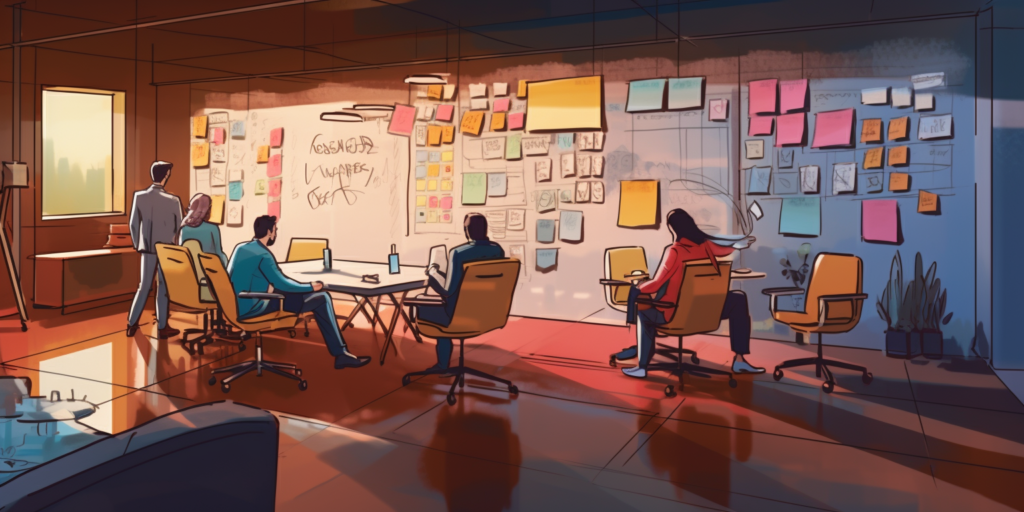
- leaner teams – Generative AI is pretty great, at a lot of generalized PM tasks. Anything that’s boilerplate or commonly used across organizations: product requirement outlines, commonly used frameworks, agendas, role descriptions, typical project plans. PMs often struggle to find enough time to write content and copy, or internal or external audiences. GPT can absolutely help with first drafts of user documentation or help content. It can also help you spin up, more personalized copy, implementation guides or docs in greater breadth or depth than you could otherwise ever do unaided. GPT and others are about 80% great at the basic stuff. It’s also pretty helpful (like in the sense of Wikipedia or google searches in the old days) for quickly learning, at least superficially, a fair bit about nearly any well-established technical, business or industry topic. And, having to know/learn a little bit about everything, is half the job product management. Generating basic code can be handy too, esp if you are a little rusty as a PM. Code interpreter can help with generating SQL or Excel VBA scripts to pull or scrub data. Up to and including kicking the tires your own or 3rd party apis with simple prototyping without fully distracting the engineering team.
Of course, LLMs are still (and I can’t stress this enough) terrible at creating ‘new’ knowledge. Generative won’t help you much with anything that was never in it’s training set. To be sure, Sam Altman’s stated goal is to create an AI that can truly invent new ideas and new knowledge. But don’t expect that to change in 2024. You still need humans to bring true insight, to separate the salient signals from the noise and to actually innovate. In theory though, today’s AI should be allowing you a little more time in your PM’s oft-harried days to actually do that.
2. New tooling – I love tools like Otter.ai and Gong that can do remarkable jobs of transcribing and annotating live internal or customer sales/service conversations, and then turning those into collaborative assets for actionable insights and roadmap ideas. New design tools like visily.ai make it possible to import screenshots to figma. A couple weeks ago, I need a way to better visualize and idea for a client. So I navigated to an archetypal customer website and screen-shotted their checkout flow into an AI-generated figma. And in the space of one cross-country flight, mocked up multiple ways my client’s embedded fintech product could transform that category of checkout experiences.
If you are looking for more, Product school also maintains a moderately updated list AI-driven PM tools.
3. Mix Shift to Hard skills – Now lets talk about building AI, not just using AI. For organizations investing in proprietary AI tech, I am seeing engineering and data science leads driving the roadmap and product strategy. Somewhat less, for now, is the primacy of the UI/experience focused PM. It used to be, the riskiest assumption in tech was, if we build it, will they come? With AI though, the riskier, more expensive feedback loop is going to be can we build it? From data sourcing to training, tuning, retrieval augmentation and scalable inference – good AI is not trivial to build. And even when you can get good results can you manage for safety, compliance, un-good edge cases? AI than some of the past waves of web and digital tech. More of your engineering backlog is going to be consumed by engineering challenges, technical features, as well as more platform engineering and  data science. We’re also likely to see more product teams led by engineering or technical leaders.
Can AI replace your product team 2024? Well hardly, but I’d hope it’s helping them work at least 10-20% smarter and more efficiently as well as helping them be stronger generalists.
Between  the above effects of efficiency and mix shifts I do see likely change for the size, process and composition of product orgs. You may see a higher working ratio of engineers and data science to traditional PM roles. Some PMs will start to feel a little un-tethered if their skill sets are less well matched now, or more of the roadmap is increasingly out of their hands. It’s a good time now to have those career conversations with your team. Change can be hard, but everything is learnable, and the future is perennially something we’ve barely started to invent yet.
